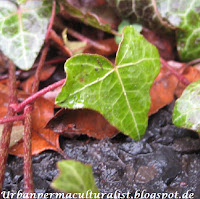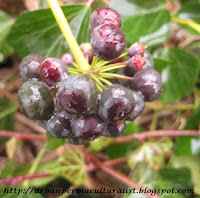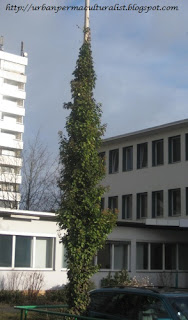Ivy Araliaceae Hedera helix
 There are a few different species of Ivy I am referring to but as they are very, very hard to tell apart
and because their ecology and growth habits are the same I am
referring to English Ivy, Irish Ivy, Atlantic Ivy and Common Ivy as the same plant. This plant
might be commonplace and seem rather uninteresting but it is also a
plant of huge ecological importance and due to limited natural
habitat, this is even more true in cities. Ivy is native to Europe and is Britain's only native evergreen shrub. It is shade tolerant and grows as both a ground cover and as a creeping vine. When Ivy grows vertically it matures and forms different leaf shapes and flowers. The juvenile plant has the characteristic pointed leaves where the adult vine has more plain looking oval leaves. It has a good tolerance to shade and can grow where many other plants cannot, like a shaded forest floor. Contrary to what many think, Ivy does not damage the trees which it is growing on. The roots do not choke the trunk and Ivy generally does not smother trees unless they are already stressed. A healthy tree would shade out ivy enough to keep its growth in check. With the exception of Ash trees, which have an open canopy.
There are a few different species of Ivy I am referring to but as they are very, very hard to tell apart
and because their ecology and growth habits are the same I am
referring to English Ivy, Irish Ivy, Atlantic Ivy and Common Ivy as the same plant. This plant
might be commonplace and seem rather uninteresting but it is also a
plant of huge ecological importance and due to limited natural
habitat, this is even more true in cities. Ivy is native to Europe and is Britain's only native evergreen shrub. It is shade tolerant and grows as both a ground cover and as a creeping vine. When Ivy grows vertically it matures and forms different leaf shapes and flowers. The juvenile plant has the characteristic pointed leaves where the adult vine has more plain looking oval leaves. It has a good tolerance to shade and can grow where many other plants cannot, like a shaded forest floor. Contrary to what many think, Ivy does not damage the trees which it is growing on. The roots do not choke the trunk and Ivy generally does not smother trees unless they are already stressed. A healthy tree would shade out ivy enough to keep its growth in check. With the exception of Ash trees, which have an open canopy. What makes this plant so
special is its fruiting period, winter. Ivy produces purple berries
in the winter months when there is little else for wildlife to eat.
It is also evergreen and so provides year round habitat for small
mammals. It is a particularly important habitat for bats, which roost in the adult foliage. Birds also build their nests in it. The pollen and nectar is a food source in fall for birds, wasps, butterflies and other invertebrates. Ivy is the primary food source for the aptly named Ivy Bee (Colletes
hederae) which feeds almost exclusively on Ivy nectar. This bee which
was recently discovered in England is now know to have a range across Europe. The foliage covers the forest floor and provides shelter from freezing and hard rains and snow. And so, it is a winter feeding site for bug eating birds and a shelter for small mammals. The berries are a winter food source for many birds like wood pigeons, starlings, thrushes and blackcaps and are high in fat.
What makes this plant so
special is its fruiting period, winter. Ivy produces purple berries
in the winter months when there is little else for wildlife to eat.
It is also evergreen and so provides year round habitat for small
mammals. It is a particularly important habitat for bats, which roost in the adult foliage. Birds also build their nests in it. The pollen and nectar is a food source in fall for birds, wasps, butterflies and other invertebrates. Ivy is the primary food source for the aptly named Ivy Bee (Colletes
hederae) which feeds almost exclusively on Ivy nectar. This bee which
was recently discovered in England is now know to have a range across Europe. The foliage covers the forest floor and provides shelter from freezing and hard rains and snow. And so, it is a winter feeding site for bug eating birds and a shelter for small mammals. The berries are a winter food source for many birds like wood pigeons, starlings, thrushes and blackcaps and are high in fat.  Also this vine is great for filtering the air and is shade
tolerant. It can grow up walls in spaces where trees cannot and is
good for reducing noise pollution and insulating walls. In fact, it is so well adapted to urban environments that you can
find it growing in the most unnatural settings like this metal flagpole. One danger ivy can cause when growing in trees is that it can make the tree top heavy and fall over during storms. Ivy is not damaging to most homes when grown up an exterior wall. If removed though, it may take some of the wall with it. It actually protects exterior walls from UV light and graffiti. If grown on a wooden fence or a home with wooden exterior it can often damage it as wood warps with time and changes shape allowing Ivy the opportunity to grow between the shingles and fencing. Ivy, if given time will completely topple over wooden fencing.
Also this vine is great for filtering the air and is shade
tolerant. It can grow up walls in spaces where trees cannot and is
good for reducing noise pollution and insulating walls. In fact, it is so well adapted to urban environments that you can
find it growing in the most unnatural settings like this metal flagpole. One danger ivy can cause when growing in trees is that it can make the tree top heavy and fall over during storms. Ivy is not damaging to most homes when grown up an exterior wall. If removed though, it may take some of the wall with it. It actually protects exterior walls from UV light and graffiti. If grown on a wooden fence or a home with wooden exterior it can often damage it as wood warps with time and changes shape allowing Ivy the opportunity to grow between the shingles and fencing. Ivy, if given time will completely topple over wooden fencing.In conclusion, Ivy is a practical plant to grow for wildlife conservation and a cleaner and a more sustainable city. It is also at home in a city and will flourish in some of the harsher environments where other plants cannot grow. I would love to see more buildings covered in vines.
Resources:
Ivy Bee fact sheet PDF at www.bwars.com
Ivy Friend or Foe at ArborEcology.co.uk
Hedera helix L. and H. hibernica (Kirchner) Bean (Araliaceae) in the British Isles at BSBI Archive

No comments:
Post a Comment
Please Leave a Comment